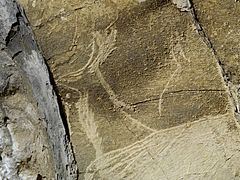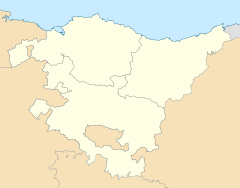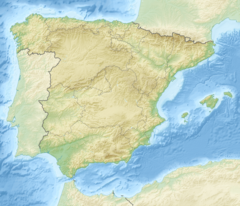Cave of Altxerri facts for kids
|
Cueva de Altxerri
|
|
 |
|
| Alternative name | Altxerriko leizea |
|---|---|
| Location | Aia, Gipuzkoa |
| Region | Basque Country |
| Coordinates | 43°16′7″N 2°8′2″W / 43.26861°N 2.13389°W |
| Official name: Altxerri | |
| Type: | Cultural |
| Criteria: | i, iii |
| Designated: | 1985 (9th session) |
| Part of: | Cave of Altamira and Paleolithic Cave Art of Northern Spain |
| Reference #: | 310-018 |
| Region: | Europe and North America |
| Official name: Cuevas de Altexerri | |
| Type: | Non-movable |
| Criteria: | Monument |
| Designated: | 17 July 1984 |
| Reference #: | RI-51-0005144 |
The Cave of Altxerri is a famous cave in the Basque Country, Spain. It is also known as "Cueva de Altxerri" in Spanish and Altxerriko leizea in Basque. This amazing cave is found in the town of Aia, in the area of Gipuzkoa.
Inside the cave, you can find ancient rock paintings and engravings. These artworks were made a very long time ago. Scientists believe they are from the end of the Upper Paleolithic period. This was a time when early humans lived, using stone tools.
Contents
Ancient Art in Altxerri Cave
The art in Altxerri Cave is very special. It belongs to a style called the Franco-Cantabrian School. This art style is known for showing animals in a very realistic way.
Oldest Paintings in Europe
In 2013, a study looked at paintings in an upper part of the cave, called Altxerri B. These paintings are thought to be the oldest stone paintings in all of Europe! They are estimated to be about 39,000 years old. Imagine how long ago that was!
Animals in the Cave
Altxerri Cave has one of the biggest collections of rock engravings in its area. There are about 120 engravings in total. Most of these, about 92, show different animals.
- The most common animal shown is the bison. There are 53 engravings of bison.
- You can also see six engravings of reindeer.
- There are four deer and four goats.
- Three horses and three aurochs (an ancient type of wild cattle) are also present.
- Two saiga antelope are shown.
- Other animals include a wolverine, a fox, a hare, and even a bird.
World Heritage Site
The Cave of Altxerri is so important that it was made a World Heritage Site in 2008. This means it is a place of special cultural value to the whole world. It is part of a larger group of caves in Northern Spain. This group is known as the Cave of Altamira and Paleolithic Cave Art of Northern Spain. There are 16 other caves included in this important group.
See also
 In Spanish: Cueva de Altxerri para niños
In Spanish: Cueva de Altxerri para niños



